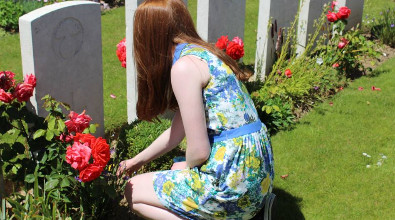My name is Anna Blair. I am 17 years old and I go to school at Laurel Hill Colaiste, Limerick City. My mom and I are both interested in history, it was she who heard about this contest on the radio and suggested I enter. My mom has been researching our ancestor, Jane Ffoulkes for the past few years, a woman of the ascendancy who fought in the 1798 rebellion and eloped with United Irishman, Thomas McKenna. She is reputed to be the Captains’ Daughter in the song ‘The Boys from Wexford ’. My mom always told me about new discoveries. She spent hours doing research and sometimes brought me with her to Listowel to visit Jane's grave and married homeland. I was surprised when I found out I won a place on this trip, but moreover, I was excited to get an opportunity to do some research of my own.
Edward didn’t leave much information behind. I found the majority of my sources by searching endlessly through the web, looking at sites such as www.nationalarchives.ie. I found his medal index card and attestation form which gave me a physical description of him, as well as, where he lived and what he was doing before he joined up. I emailed a local historian from Rathkeale, Patrick Coleman, who helped me a lot by giving me a context of the time and referring me to other people who could help.
I’ve visited Rathkeale a few times and talked to a man who owns a men’s clothes shop, who remembered the Kiernans, from his childhood in the 1940s. As I learned more about Edward, I found myself coming to a lot of dead ends. Firstly, I couldn’t find any notice for Edward’s death; I spent an afternoon in the Granary library looking at old newspapers, using a microfiche reader, to no avail. I tried calling all the Kiernans in the phonebook but none of them knew of Edward. Edward’s family moved out of Rathkeale in the 40’s, I’ve no idea where they are now.
My Sketchbook
Left: 'Operation Sea Lion' (Unternehmen Seelowe) by Anselm Kiefer, 1975. This piece reminded me of the WW1 headstones.Right: A page from my sketchbook
Here I tried to portray Ireland's attitude towards the war in the years after it ended.
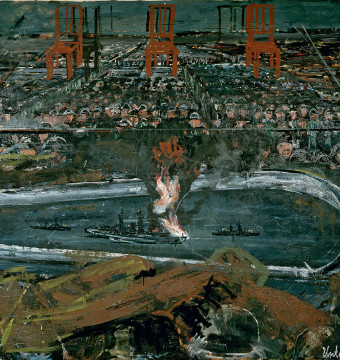
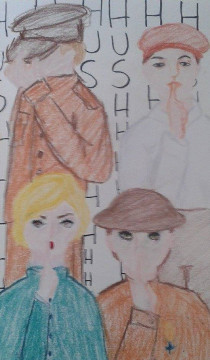
Aside from getting a chance to do historical research, I was equally excited to treat this research as an art project. I’m doing art for the leaving cert and it’s my most important subject. I hope to study Architecture in UL and then do a post-graduate course in Fine Art in Central Saint Martins. Art is my passion and I couldn’t think of a better way to sort out my thoughts on Edward than to dedicate a sketchbook to him and to try and make sense of him and the war through art. It proved to be more difficult than I initially thought it would be…the more I learned about the war and Edward, the harder I found it to sum them up with art. I was scared I would mess up or make something politically incorrect, however, I have worked on it and I can’t wait to see how my work before France will differ from the sketches I do in France and afterwards. In October, I went on a school trip to London with my year. My art teacher, Cait Ni Dhuinin brought me and three of my friends with her to the Royal Academy to see an Anselm Kiefer exhibition, while the rest of the year went to other art galleries. It was there that I saw a piece called ‘Operation Sea Lion’ which has inspired my art. It depicts a scene which I thought at first was a cityscape. It was only after a minute or two that I realized that what I thought were buildings, were actually men: soldiers. It really struck me how they looked so manmade. They reminded me of the architectural structure of the Commonwealth cemeteries.
Left and right: Here are photos I took in a park near Edward's house. I used white pen and marker to draw over them. On the left is a boy who represents Edward as a child.
On the right, the landscape has changed: I tried to make it look like a battlefield.
(Please remember these are from a sketchbook, I did them usually within 10-30 minutes. Please don't look at them as finished pieces).
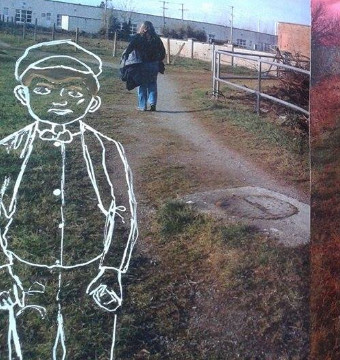
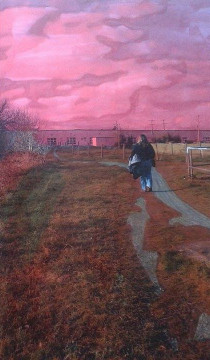
Thanks
I would like to thank everyone who has helped me along the way; my mom, my school and history teacher Valerie O’Shea, Patrick Coleman, the people of Rathkeale and of course, Gerry and the team for giving me this once in a lifetime opportunity. I can’t wait to go to France and Belgium, to meet all the other students and especially, to visit Edward’s grave.
